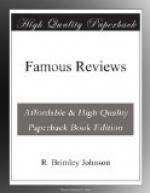[1] “Adam Bede,” i. 228; ii. 75. [2] ibid., i. 119.
Her conduct throughout is such as to offend and disgust; and the authoress does not seem to be sufficiently aware that, while the descriptions of the little coquette’s beauty leave that to be imagined, her follies and faults and crimes are set before us as matters of hard, unmistakeable fact, so that the reader is in no danger of being blinded by the charms which blinded Adam Bede, and Hetty consequently appears as little else than contemptible when she is not odious. Yet it is on this silly, heartless, and wicked little thing that the interest of the story is made to rest. Her agonies, as we have already said, are depicted with very great power; yet, if they touch our hearts, it is merely because they are agonies, and our feeling is unmixed with any regard for the sufferer herself.
This habit of representing her characters without any concealment of their faults is, no doubt, connected with that faculty which enables the authoress to give them so remarkable an air of reality. There are, indeed, exceptions to this, as there are in almost every work of fiction. Thus, Sir Christopher and Lady Cheverel strike us as old acquaintances whom we have known not in real life, but in books. We are not altogether sure of stately old Mrs. Irwine, and are sceptical as to Dinah Morris, notwithstanding the very great pains which the authoress has evidently bestowed on her—perhaps because she is utterly unlike such female Methodists as have fallen within our own (happily, small) experience; and Bob Jakin is a grotesque caricature, which would have been far better done by Mr. Dickens, who is undeniably great in the production of grotesques, although we do not remember that throughout the whole of his voluminous works he has ever succeeded in embodying a single natural and lifelike character. But, with a very few exceptions, “George Eliot’s” personages have that appearance of reality in which those of Mr. Dickens are so conspicuously wanting. And while Mr. Dickens’s views of English life and society are about as far from the truth as those of the French dramatists and romancers, “George Eliot” is able to represent the social circumstances in which her action is laid with the strongest appearance of verisimilitude. We may not ourselves have known Shepperton, or Hayslope, or St. Ogg’s; but we feel as much at home in them as if we had....
Tulliver may be cited as another well-imagined and well-executed character, with his downright impetuous honesty, his hatred of “raskills,” and his disposition to see rascality everywhere; his resolution to stand on his rights, his good-natured contempt for his wife, his very justifiable dislike of her sisters, his love for his children, and his determination that they shall have a good education, cost what it may,—the benefits of education having been impressed on his mind by his own inability to “wrap up things in words as aren’t actionable,” and by




